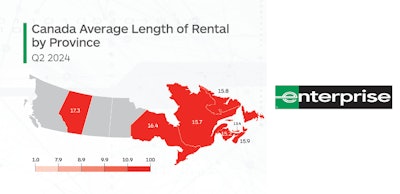
Ottawa, Ontario — The Canada-wide length of rental (LOR) for collision-related rentals in Q2 2024 was 15.5 days, marking a 1.3-day decline from the same quarter of 2023 but an increase compared to pre-pandemic levels, according to Enterprise’s most recent LOR report.
Alberta reported the highest LOR at 17.3 days, a 0.3-day increase. It was the only province to see higher results than Q2 2023.
Ontario had the second-highest LOR at 16.4 days, representing a 1.9-day decline from Q2 2023.
Prince Edward Island had the lowest LOR at 13.4 days, a significant 6.5-day decline from Q2 2023.
The drivable LOR for Q2 2024 was 12.2 days, marking a minor decline of 0.1 from Q2 2023. Alberta again recorded the highest drivable LOR in the country at 13.6 days, a 0.5-day increase from Q2 2023. Ontario was the next highest at 13.3 days, a 0.4-day decline. Similarly, P.E.I. had the lowest drivable LOR at 9.1 days—a 4.4-day drop.
For non-drivable LOR, overall rates for Q2 2024 came in at 28 days, a 2.4-day drop from Q2 2023. Newfoundland and Labrador had the highest non-drivable LOR at 35.7 days—a significant decrease of 7.5 days from the same time last year.
The second-highest LOR was Alberta at 34 days. Nova Scotia and P.E.I. came in second as the only two additional provinces that had results higher than the 30-day mark.
Comparatively, of all provinces, Quebec had the lowest non-drivable LOR at 22.4 days, and all provinces saw non-drivable LOR decreases this quarter. However, when comparing Q2 2024 with Q2 2021, non-drivable LOR has increased by 10.9 days.
Finally, when looking at LOR for total losses, total-loss affiliated rentals for the country were 21.2 days in Q2 2024, a 3.1-day decrease from Q2 2023.
Here, P.E.I. had the highest LOR at 38.4 days, which was an 8.6-day increase from Q2 2023. All other provinces had total loss LOR decreases, with Alberta seeing a minor 0.1-day drop to Quebec seeing a more significant reduction of 12.3 days.
When comparing to Q2 2023, Canada’s total loss frequency increased to 18.8 percent, up from 17.9 percent in 2023. Enterprise’s report notes that “as vehicle values continue to decline, we expect total loss frequency to gradually increase as well, especially with severity gains not showing any signs of abating. With more vehicles being written off, the higher dollar repairs are no longer flowing into repair facilities and overall repairable volumes will decline, creating fewer bottlenecks and delays in repair facilities.”
To see Enterprise’s full report, click here.





















